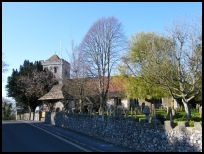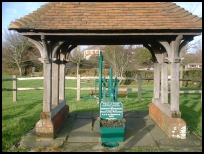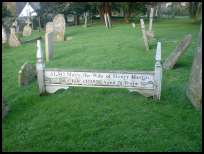|
| |
 Archaeology reveals an early use by the English of the Romano-British cemetery
at Ringmer in East Sussex. The majority of the graves contain inhumation burials which either
points to late colonization or close contact with the British population. Saucer
brooches found in the graves indicates the presence of Saxons from the
Elbe-Weser area, so presumably the Saxons lead by Aella came here. Archaeology reveals an early use by the English of the Romano-British cemetery
at Ringmer in East Sussex. The majority of the graves contain inhumation burials which either
points to late colonization or close contact with the British population. Saucer
brooches found in the graves indicates the presence of Saxons from the
Elbe-Weser area, so presumably the Saxons lead by Aella came here.
The church is a good example of one of those in the area which is roofed
in Horsham Tiles .
In the 1600's the vicars daughter married John Harvard , the founder of
Harvard University in the United States of America and the daughter of
Sir William Springett married William Penn the founder of Pennsylvania.
Ringmer must have had very poor roads as in a letter in 1743, the
Wealden Ironmaster John Fuller admitted that he had sent
29 x 9 pounder cannons from Heathfield to Lewes , which passed through
Ringmer , and these had torn the road with the carts and oxen such that
no one could follow them.
Gilbert White, the naturalist visited the Snooke family at the vicarage
during the late 1700's. The vicars wife Rebecca had a tortoise which
Gilbert wrote about. When Mrs Snooke died, the tortoise went to live
with Gilbert in his home at Selbourne in Hampshire. The tortoise is
remembered in the village sign, and its shell is preserved in the British
Museum.
(Many thanks to John Kay of the Ringmer History Study Group for the following clarification)
It is true that Ringmer had a vicar called Rev Henry Snooke (vicar
1690-1727: who lived
at the vicarage, and it is also true that Gilbert White's aunt Rebecca
Snooke was the widow of a Henry Snooke, but they are father and son,
not the same person. When Gilbert White visited his aunt Rebecca in
the 1770s and early 1780s she lived at Delves House, a pleasant house
in large grounds facing Ringmer Green, on the other side of the church
from the vicarage (as GW makes clear in his letters and journal,
especially when writing about the tortoise). The tortoise was called
Timothy, and her shell is preserved in the Natural History
Museum in Kensington (not the British Museum).
Ringmer Green was the meeting point for local farm labourers in 1831, 150
of them met Lord Gage from nearby Firle to complain of mistreatment by his
overseer, he sacked the overseer and gave the workers a pay rise. The riots
were the last peasant revolts in the UK and were known as the Swing Riots .
(Many thanks to John Kay of the Ringmer History Study Group for the following clarification)
The target of the Ringmer Swing Riot was primarily the wage rates paid
to labourers 'on the parish' and other social security benefits, but
they did also complain about the Ringmer parish assistant overseer
John Finch [paid parish official who had for several years run the Old
Poor Law on behalf of the (unpaid) parish Overseers of the Poor].
There was also a separate complaint against Lord Gage's woodreeve, for
participating in the 'roundsman' system, which was designed to
stimulate employment but easily lent itself to abuse.
This event took place on Ringmer Green in November 1830, not in 1831,
and was reported at length in the Times and local newspapers. The
number of labourers who gathered, fairly peaceably, on Ringmer Green
was variously estimated at 150-300, but was certainly a lot larger
than the number of vestrymen gathered, with the Vicar, inside the
Workhouse. The labourers did gain a 50% pay rise - for married men
from 1s 8d per day (10s 0d per week) to 2s 6d per day (15s 0d per
week). This new rate lasted all of 6 weeks, but some gains persisted
until wages were finally cut right back to 1s 8d per day in May 1832.
However, neither the Overseers of the Poor nor the Assistant Overseer
were sacked - the voluminous parish records continue in John Finch's
firm and legible hand for several more years, as do his regular salary
payments. Lord Gage couldn't sack his Plashett Park woodreeve -
Richard Devenish had already died. |
|
 The churchyard contains some unusual wooden graveboards, which are worth
investigating, and also the church roof contains Horsham roofing slabs . The churchyard contains some unusual wooden graveboards, which are worth
investigating, and also the church roof contains Horsham roofing slabs .
The village Green is large and pleasant to look at, with a pair of old
hand water pumps, on at the north and one at the south edge of the green.
Mount Caburn towers over the village to the south. |
|
 Ringmer in East Sussex has quite a few local shops, but the main shopping centre is
in nearby Lewes about 3 miles to the west. Ringmer in East Sussex has quite a few local shops, but the main shopping centre is
in nearby Lewes about 3 miles to the west.
Trains can be caught again at Lewes , and busses pass through the village
from Heathfield and Hailsham to Lewes . |
|
| Ringmer is shown as the red symbol on the map. |
|
|
Nearby Villages
(click on symbol to see the village page) |
| Village= | |
Town= | |
Recorded in Domesday= |  |
| |
|
|
Arlington |
(Peaceful Saxon Village) | | 6.84 miles |
|
|
Barcombe |
(Village in three places) | | 2.17 miles |
|
|
Beddingham |
(At the base of Mount Caburn) | | 2.68 miles |
|
|
Chalvington |
(The miniature church) | | 5.00 miles |
|
|
Chiddingly |
(Walking on Cheese ??) | | 6.24 miles |
|
|
East Hoathly |
(Another Sussex Cannibal?) | | 5.38 miles |
|
|
Glynde |
(Home of English Opera) | | 2.20 miles |
|
|
Halland |
(Ancient Slaughter) | | 4.38 miles |
|
|
Isfield |
(Simon de Montfort and the Lavender Line) | | 2.97 miles |
|
|
Laughton |
(Knight captures King of France) | | 3.53 miles |
|
|
Ripe |
(Earl Harolds estate) | | 4.18 miles |
|
|
Selmeston |
(Tomb to store the Contraband) | | 5.19 miles |
|
|
Firle |
(Home of the Greengage) | | 3.57 miles |
|
|